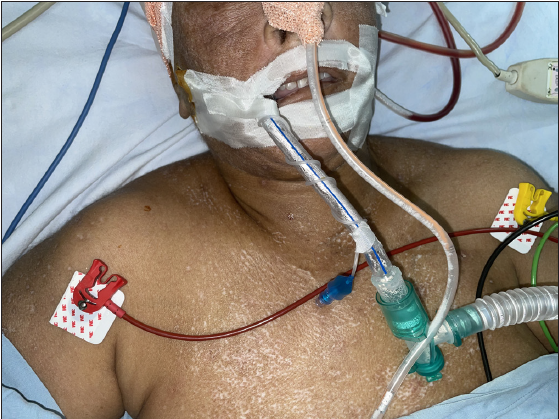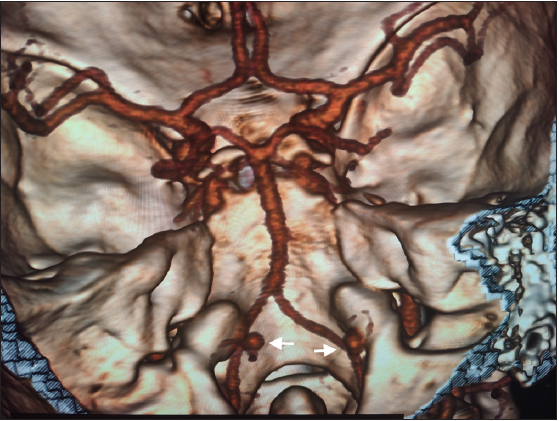Translate this page into:
Intracranial aneurysms and systemic sclerosis: A causal association or sheer coincidence?
Corresponding author: Dr. Keshavamurthy Vinay, Department of Dermatology, Venereology and Leprology, Postgraduate Institute of Medical Education and Research, Chandigarh, India. vinay.keshavmurthy@gmail.com
-
Received: ,
Accepted: ,
How to cite this article: Mustari AP, Reddy A, Thind A, Gendle C, Vinay K. Intracranial aneurysms and systemic sclerosis: A causal association or sheer coincidence? Indian J Dermatol Venereol Leprol. 2025;91:103-5. doi: 10.25259/IJDVL_481_2023
Dear Editor,
Systemic sclerosis is a chronic inflammatory autoimmune disease characterised by microvascular damage and fibrosis of the skin and systemic organs. The main targets of the disease are the skin and viscera like the lung, heart, kidney and gastrointestinal system. Contrary to other collagen disorders, involvement of the nervous system has rarely been reported and has largely been attributed to the paucity of connective tissue in the brain with the sparse media and adventitia in the intracerebral arteries.1 We report a case of systemic sclerosis associated with an intracranial aneurysm.
A 57-year-old woman, a homemaker, presented with a sudden onset severe headache associated with vomiting and transient loss of consciousness 12 hours before. A general physical examination revealed a Glasgow Coma Score of 14 (E4M4V6) and bilateral reactive pupils. The rest of the vitals and sensory and motor examination were within normal limits. Cutaneous examination revealed binding down of the skin on the upper limbs extending proximal to the elbows, face and lower limbs (modified Rodnan skin score: 11). Multiple, irregularly distributed, depigmented macules on the face and upper trunk with perifollicular pigment retention at places resembling salt-and-pepper appearance and positive Ingram sign were also noted [Figure 1]. Haemogram showed anaemia (Hb; 8.5g/dl), renal function tests, liver function tests, coagulation profile and serum electrolytes were within normal limits and urinalysis showed proteinuria. Antinuclear antibody was positive (3+, nucleolar and coarse speckled). The clinical and immunological profiles were suggestive of diffuse cutaneous systemic sclerosis.

- Depigmented macules on the face and chest resembling salt-and-pepper pigmentation.
Computed tomography angiography of the head showed multiple aneurysms at the origin of the posterior inferior cerebellar artery [Figure 2], diffuse subarachnoid haemorrhage and hydrocephalus. Magnetic resonance imaging and digital subtraction angiography confirmed the rupture of the right posterior inferior cerebellar artery aneurysm (5.1 mm × 4.4 mm) and the patient underwent craniotomy and clipping of the same. However, on postoperative day 4, she developed pulmonary oedema and myocardial dysfunction secondary to severe vasospasm and expired.

- Computed tomography angiography image of the brain showing bilateral aneurysms at the origin of the posterior inferior cerebellar artery (white arrows).
The mechanism of aneurysm formation in systemic sclerosis is poorly understood. The proposed hypotheses are: (a) weakening of the vessel wall due to narrowing of the lumen of vasa vasorum due to fibrosis; (b) renal dysfunction leading to hypertension which is a risk factor for aneurysms; (c) increased risk of atherosclerosis which in turn is a risk factor for aneurysms and (d) anti-cell antibodies, reactive oxygen species and inflammatory cytokines leading to endothelial damage.1
The occurrence of intracranial aneurysms in systemic sclerosis patients raises the question of the relationship between these two. We believe that systemic sclerosis has a causal relationship with the development of aneurysms because of clinical and pathological differences from idiopathic/vasculopathic intracranial aneurysms. Systemic sclerosis-associated aneurysms are usually large (>1 cm), multiple, fusiform in shape and present later in life in the sixth decade [Table 1].2–7 The higher incidence of large aneurysms in systemic sclerosis can be explained by excessive production of the extracellular matrix which prevents rupture of aneurysms. Even though the excessive extracellular matrix in systemic sclerosis prevents the rupture of aneurysms for a while, they eventually rupture, leading to subarachnoid haemorrhage.1,3,7 The multiple aneurysms in systemic sclerosis are probably due to the diffuse nature of the autoimmune process.7 In contrast, idiopathic aneurysms and vasculitis-associated aneurysms present early (30–40 years), are smaller, involve distal arteries and rupture easily.
| Authors | Year | Age/sex | Diagnosis | Clinical presentation | Location of aneurysm | Shape | Size (range) | Treatment | Outcome |
|---|---|---|---|---|---|---|---|---|---|
| Ortiz et al.2 | 1991 | 66/F | CREST | Gradual bilateral vision loss |
Right ICA (two) Left ICA (three) Right MCA (one) |
Saccular | 1.6 to 12 mm | Surgical clipping and reinforced with muslin | NA |
| Blaustein et al.3 | 1999 | 57/F | CREST | SAH | Basilar artery | Saccular | NA | Surgical clipping | NA |
| Kaku et al.1 | 2004 | 73/F | DcSSc | SAH | Left MCA and right ACA | Saccular | Small | Surgical clipping | Neurologically normal |
| 65/F | DcSSc | SAH | Basilar artery | Saccular | Small | Surgical clipping | Neurologically normal | ||
| 52/M | DcSSc | SAH | Let PCA | Fusiform | NA | No surgical treatment | Neurologically intact with no further episodes of SAH | ||
| 62F | DcSSc | Ataxia | Basilar artery (two) | Fusiform | Small | Endovascular (coiling) | Neurologically normal | ||
| Left vertebral artery | Saccular | Giant | |||||||
| Zoumalan et al.4 | 2004 | 50/F | CREST | Migraine | Right ICA | Saccular | Surgical clipping | The patient’s recovery was uneventful | |
| Nakae et al.5 | 2009 | 53/F | CREST | TIA |
Right MCA Left MCA Left ICA Left ACA |
Saccular | 2–12 mm | Surgical clipping | No neurological deficit |
| 64/F | CREST | Incidental | Left MCA | Fusiform | NA | Surgery (wrapping with autologous fascia and coating with fibrin glue) | No neurological deficit | ||
| Masuoka et al.6 | 2010 | 61/F | CREST | Incidental (Evaluation of tinnitus) |
Right ICA (three) Left ICA |
Saccular | 2.7–9 mm | Surgical clipping | No neurological deficit |
| Jabre et al.7 | 2020 | 67M | DcSSc | SAH |
Right MCA ACoA |
Saccular | 5–25 mm | Surgical clipping | NA |
| Our case | 2023 | 57/F | DcSSc | SAH |
Right ACA Vertebral artery (two) |
Saccular | 3.1–5.1 mm | Surgical clipping | Death on postoperative day 4 |
CREST: calcinosis, Raynaud phenomenon, oesophageal dysmotility, sclerodactyly and telangiectasia; DcSSc: diffuse cutaneous systemic sclerosis; SAH: subarachnoid haemorrhage; NA:, not available; ACA: anterior cerebral artery; ACoA: anterior communicating artery; ICA: internal carotid artery; MCA: middle cerebral artery; PCA: posterior cerebral artery; TIA: transient ischemic attack; small, diameter: < 5 mm; giant diameter: > 25 mm
This case highlights the increased risk of aneurysms in systemic sclerosis and screening for intracranial aneurysms may be considered in individuals who present with clinical features of intracranial aneurysm (headache, dizziness and cranial nerve palsy) and prophylactic clipping of aneurysms may help in patients who are at risk of rupture (before subarachnoid haemorrhage and documented enlargement of aneurysm). Further prospective studies with large sample sizes are required to know the true incidence of intracranial aneurysms in systemic sclerosis.
Declaration of patient consent
The authors certify that they have obtained all appropriate patient consent.
Financial support and sponsorship
Nil.
Conflicts of interest
There are no conflicts of interest.
Use of artificial intelligence (AI)-assisted technology for manuscript preparation
The authors confirm that there was no use of artificial intelligence (AI)-assisted technology for assisting in the writing or editing of the manuscript and no images were manipulated using AI.
References
- Cerebral aneurysms in scleroderma. Cerebrovasc Dis. 2004;17:339-41.
- [CrossRef] [PubMed] [Google Scholar]
- CREST-associated multiple intracranial aneurysms and bilateral optic neuopathies. J Clin Neuro-ophtalmology. 1991;11:233-40.
- [Google Scholar]
- Synchronous intracranial aneurysm clipping and coronary artery bypass grafting in a scleroderma patient with a subarachnoid hemorrhage and an acute myocardial infarction. A case report. J Cardiovasc Surg (Torino). 1999;40:55-7.
- [Google Scholar]
- Association of an irregularity shaped anterior choroidal aneurysm with CREST syndrome. J Neurosurg. 2004;101:854-7.
- [Google Scholar]
- Intracranial aneurysms in patients with CREST syndrome. Neurol Med Chir. 2009;49:402-6.
- [Google Scholar]
- Multiple cerebral aneurysms in a patient with CREST syndrome. J Clin Neurosci. 2010;17:1049-51.
- [CrossRef] [PubMed] [Google Scholar]
- Scleroderma’s possible dual role in the pathophysiology of intracranial aneurysms: Case report and literature review. World Neurosurg. 2020;141:267-71.
- [Google Scholar]





